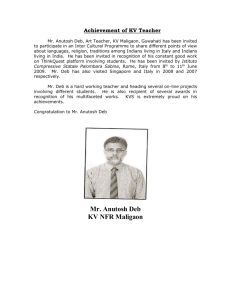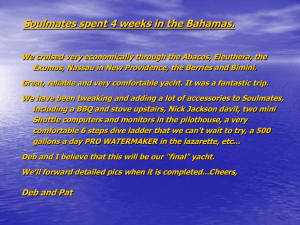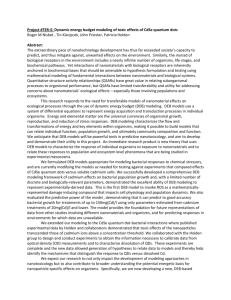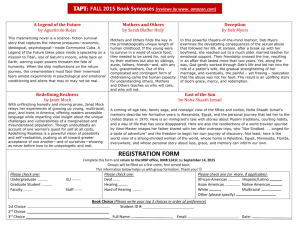DEB in practice
advertisement
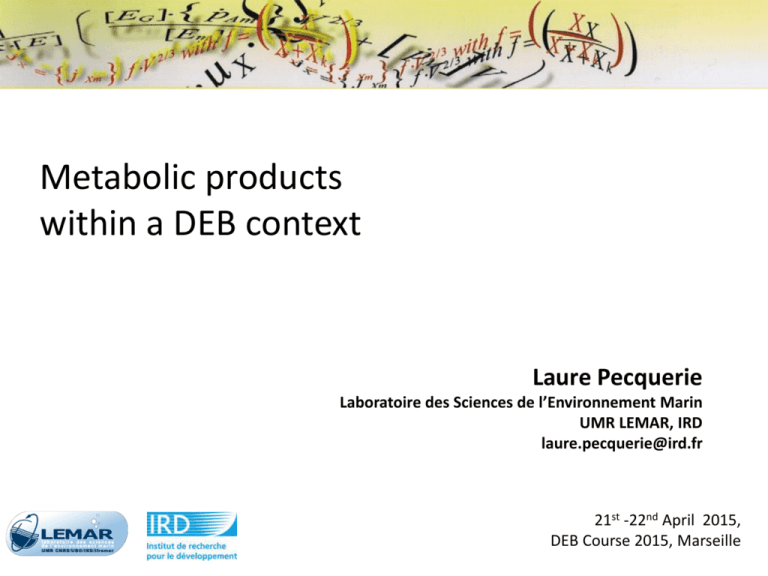
Metabolic products within a DEB context Laure Pecquerie Laboratoire des Sciences de l’Environnement Marin UMR LEMAR, IRD laure.pecquerie@ird.fr 21st -22nd April 2015, DEB Course 2015, Marseille Respiration in bioenergetic models • The conceptual relationship between respiration and use of energy has changed with time. – Von Bertalanffy identified it with anabolic processes, – while e.g. a Scope For model relates it to catabolic processes • DEB theory relates it to the three transformations : assimilation, dissipation and growth (which all have an anabolic and a catabolic components) • DEB theory defines O2 consumption and CO2 production as product “formations” and not as mechanistic processes (ie fluxes driving the dynamics of the state variables) Outline lecture 1 (Tue. 21. ) and 2 (Wed. 22.) • [A bit of networking] • Definition of products in a DEB context • Example : Torpedo marmorata – Univariate data t-L, L-W – Respiration data L-JO • Steps to calculate the respiration rate from the standard DEB expressed in an energy-length-time framework • Hard to believe at first (for me!) but true (and we gained a lot of insights from it) : otoliths and other biocarbonates are also DEB products 2005 2015 and next! • Participant of the Brest group of the 2005 DEB telecourse : 10th DEB anniversary for Jonathan, Fred, me and a few others you’ll meet Changed the direction of my anchovy PhD project Helped me getting an interview for a post-doc position in Santa Barbara with Roger Nisbet Got me a job in Brest ! • Brest group: DEB applications inmarine ecology, aquaculture and fisheries sciences: 16 people! 3 assistant professors, 6 researchers, 2 associated researchers, 1 post-doc, 4 PhD students + 5 Master and PhD students in the US, Peru and Mexico Call for Post-docs and PhD’s contact us! Grand merci : Bas, Roger, Brest group – Jonathan, Fred, Marianne, Cédric and Véro - , and Starrlight, Dina and Gonçalo for taking me on board Respiration rate as a function of length Allometric model = 2 parameters R = aLb = 0.0516 L2.437 Daphnia pulex (Kooijman, 2010) Respiration rate as a function of length Allometric model = 2 parameters R = aLb = 0.0516 L2.437 R = aL2 + bL3 = 0.0336 L2 + 0.01845 L3 DEB model = same number of parameters but parameters with measureable dimensions Daphnia pulex (Kooijman, 2010) Respiration rate as a function of length Assimilation proportional to L2 R = aLb = 0.0516 L2.437 R = aL2 + bL3 = 0.0336 L2 + 0.01845 L3 Dissipation prop to L3 Growth prop. to L2 and L3 Daphnia pulex (Kooijman, 2010) Respiration in DEB theory • Weighted sum of L2 and L3 processes as product formation is a weighted sum of : – Assimilation (L2), – Dissipation(L3 - and L2) and – Growth (L3 and L2) • Definition of Dissipation : sum of somatic maintenance, maturity maintenance, development and reproduction overheads pD = pS + pJ + pR For embryos and juveniles pD = pS + pJ +(1- kapR )pR For adults Definition of products in a DEB context (a) (b) Food (a) Assimilation Products Assimilation pA Food (b) Faeces Reserve Growth Reserve Products Growth Products Growth pG Growth pG pC 1 Somatic maintenance pM Somatic maintenance pM Structure Structure Fa pA Assimilation Products Assimilation pA Dissipation Products pC 1 (c) Maturity maintenance pJ Maturity maintenance pJ Dissipation Products pA (c) CO2 (d) ReproductionReproduction pR Reproduction buffer C pA pD pG Reproduction pR buffer (d) pA pD pG pD pG pD pG Product formation can occur during one, two or all the three DEB transformations : assimilation, dissipation and growth (a) (b) Food (a) Assimilation Products Assimilation pA Food (b) Faeces Reserve Growth Reserve Products Growth Products Growth pG Growth pG pC 1 Somatic maintenance pM Somatic maintenance pM Structure Structure Fa pA Assimilation Products Assimilation pA Dissipation Products pC 1 (c) Maturity maintenance pJ Maturity maintenance pJ Dissipation Products pA (c) CO2 (d) ReproductionReproduction pR Reproduction buffer C pA pD pG Reproduction pR buffer (d) pA pD pG pD pG pD pG Torpedo marmorata example • Constant food and temperature = 15°C • Weight, length and respiration data from birth to max age • Time (d), Wet weight (g) , Total length (cm), Respiration rate (mg O2 /h) • Let’s start with the first 2 univariate datasets: t-L and L-W t-L and L-W predictions • Defined in predict_Torpedo_marmorata.m • Lw as a function of t? – Constant food von Bertalanffy growth L_w = L_wi – (L_wi – L_wb) * exp( -r_BT * t) – L_wi? L_wb? r_BT? t? • Ww as a function of Lw ? – Constant food constant reserve density – Ww = Ww_V + Ww_E (+ Ww_ER) predict_Torpedo_marmorata.m • t = time from birth to max age : defined in mydata_Torpedo_marmorata.m • Parameters – – – – v: primary parameter defined in pars_init_Torpedo_marmorata.m T_A : environmental parameter k_M, L_m, g, k, v_Hb: computed in parscomp_st.m del_M : auxiliary param defined in pars_init_Torpedo_marmorata.m • Environment – X f: treated as param defined in pars_init_Torpedo_marmorata.m – T TC_tL : calculated by tempcorr.m TC_tL = tempcorr(temp.tL, T_ref, T_A); • Initial conditions : at E_Hb defined in pars_init_Torpedo_marmorata.m – L_b (NOTA : E_b = f [E_m]L_b, E_Rb = 0) calculated by get_lb.m pars_lb = [g; k; v_Hb] – Lw_b = get_lb(pars_lb, f) * L_m/ del_M; • Von Bertalanffy parameters – rB = 1 / (3 kM + 3 f L_m / v) – Lw_i = f * L_m / del_M predict_Torpedo_marmorata.m • Calculation – EL = Lw_i - (Lw_i - Lw_b) * exp( - TC_tL * r_B * tL(:,1)); – Ww_V = (EL * del_M)^3 assumption that d_V = 1 g/cm^3 for wet weight – Ww_E = (EL * del_M)^3 * f * w with w = m_Em * w_E * d_E/ d_V/ w_V; L-JO predictions • Hold your breath, we’ll dive deeper into DEB notations!
